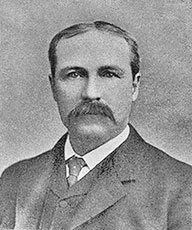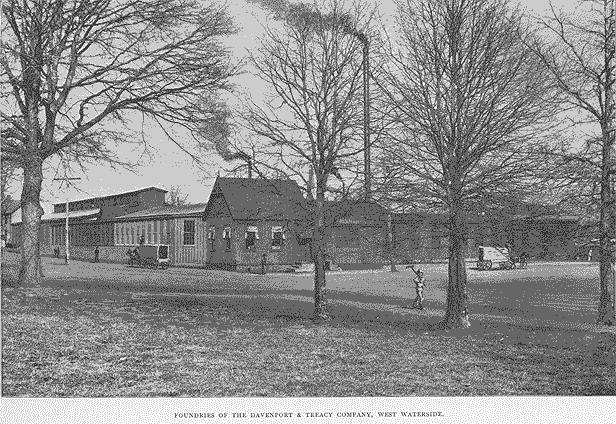| Join | Official Historian | City of Stamford | Blog | About Us | |
| Jewish Historical Society | Civil War Roundtable | Contact Us | |
|
|
|
|
Picturesque Stamford, 1892Manufacturing Industries, Pages 244 ff.THE DAVENPORT & TREACY COMPANY.
The business represented by this firm was established in 1868, and the company incorporated in 1876. The entire capital stock is now owned and controlled by John Davenport and Daniel F. Treacy. The works were first located corner of Third Avenue and Fifty-seventh Street, New York, but were removed to Jersey City in the fall of 1872, remaining there until 1887. It was then found that the Jersey City works were inadequate for the rapidly growing business, and the present site in Stamford was obtained, a new foundry and other buildings were erected, and they settled down to a specialty of piano-plates and piano hardware. With the excellent facilities at their disposal, assisted by a generous commercial enterprise and a solid backing of sound practical knowledge of all the requirements necessary to produce the finest grade of plates, gained in sixteen years' experience, immediate success followed. Success is such a handy word, and is so often used, that it hardly expresses the situation in this case. The amount of success that has fallen to their lot may be estimated by the fact that from 275 plates in 1884, they developed a patronage so large that in 1891, as their books indicate, they produced the enormous quantity of 23,400 piano plates and a correspondingly large output of piano hardware. The present location at West Waterside was chosen after careful deliberation, because it places them within easy access of piano manufactories by rail or boat. Their works reach the water's edge, and give them unexceptionable advantages in receiving their iron and coal, as well as material for general purposes. Their buildings have a street frontage of about 475 feet, and cover about three acres of ground. Anticipating further progress, they have ample space for the enlargement of their works. The Davenport & Treacy Company also maintain finishing rooms in New York city, at the corner of Avenue D and Eleventh Street, where are also located their principal offices. They employ about 130 hands at the Stamford Works, and 23 at the New York factory. Spollane's " History of the American Pianoforte" says: "This concern stands to-day, the largest producers of piano plates in the world. In sketching out the history of Davenport and Treacy and their unprecedented rise to an important place in relation to piano manufacturing in this country, an interesting chapter is unfolded. Both gentlemen, in addition to possessing high business qualities, have always taken pains to merit the good-will and esteem of the piano trade and the musical press, and are highly esteemed as private citizens. Within the domain of their business interests they are highly progressive and liberal. They have succeeded only by honorable methods, and are altogether a firm entitled to eminent esteem and favor, and are no small factor in the statistics of the piano trade." The leading member of the firm is connected with a family which has been intimately and honorably identified with Stamford for more than two centuries. The historical pages of this book contain so many allusions to the Davenport family, that further reference thereto is uncalled for here. John Davenport was born in Stamford in 1840 and at the age of nineteen entered the employ of his father at the Stillwater Iron Works. He withdrew in 1863, but retained an interest in the business until 1880. In 1863 he entered into partnership with William M. Betts, the firm being Davenport & Betts, who manufactured light machinery and tools for boring oil wells, their works being situated where the Collender factory is now built. In 1866 he retired from business temporarily and spent two years in laying out the grounds and building his present handsome residence on the Sound. In 1868 he purchased the Brown Scale Works and Foundry at Third Avenue and Fifty-seventh Street, New York. These works were removed to Jersey City and the business was extended, as already related. Daniel F. Treacy is a native of the province of New Brunswick. He served an apprenticeship at the molder's trade, and upon the termination of that engagement, removed with his father's family to St. Louis, Mo., where he acquired a varied experience with the Carondelet Iron Works. After drifting about considerably, finding employment in the best shops in the principal cities of the United States, he found himself, in 1806, in New Bedford, Mass. Here his love for the ocean, acquired in his youth, combined with restlessness, induced him to ship on a whaling-vessel bound on a three-years' cruise. In 1870 he became foreman of large iron works at New Bedford, but subsequently removed to Brooklyn and entered the employ of Mr. Davenport as Superintendent, becoming later an equal partner in the business. Mr. Treacy has remarkable professional and scientific attainments.
History of the American Pianoforte: Its Technical Development, and the Trade by Daniel Spillane, 1892 (Google Books) covers the company on Pages 332 through 338. Picturesque Stamford, 1892 |
|
|
|
|

